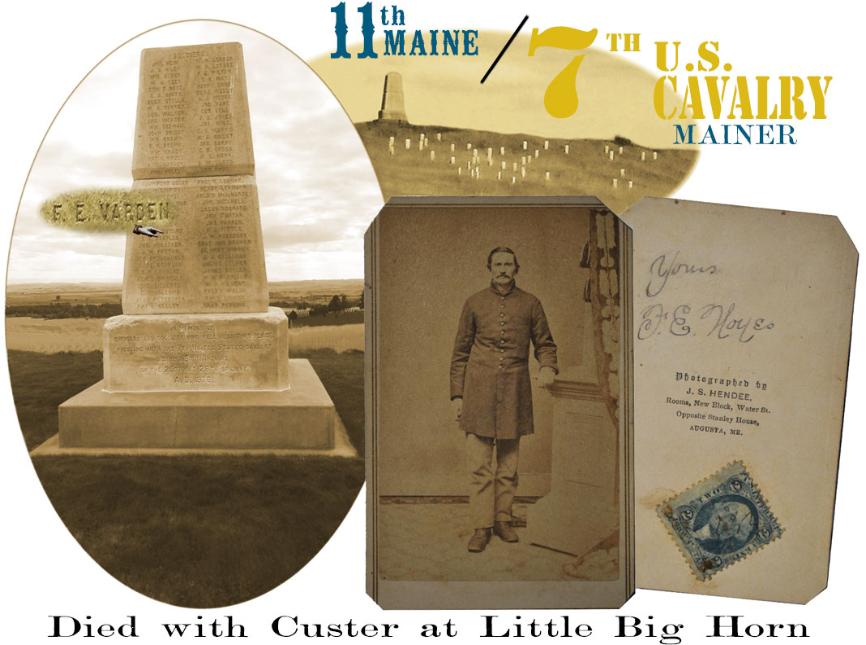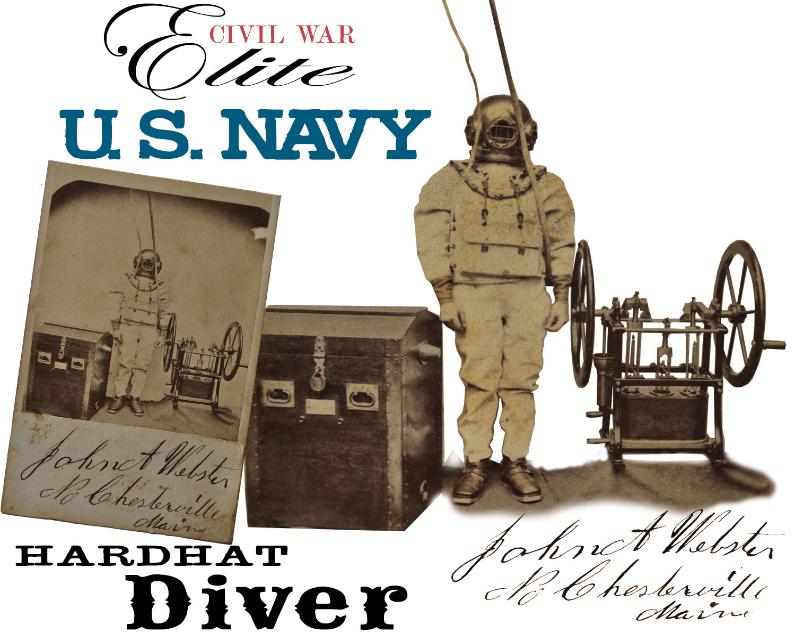

It should be noted here that there were 8 Mainers serving in the 7th U. S. Cavalry in June of 1876 of that number 5 were with the Regiment at Little Bighorn, 4 were killed with one MIA presumed killed All 5 Mainers rest in the mass grave on Last Stand Hill, Little Bighorn Battlefield, Montana.

FOR THE HOME FOLKS
Union Navy Diver John A. Webster.
Stands before the camera lens in full armor. His cumbersome gear to include the compressor are of the type produced by the Alfred Hale Co. (a.k.a. Alfred Hale Rubber Co.) of Boston, Massachusetts
Frank E. Noyes was a burly eighteen year old resident of Brunswick, Maine when on November 7, 1861 he enlisted and was mustered in as a Private of Co. A 11th Maine Volunteer Infantry. His soon to become battle hardened 11th Maine moved quickly for the seat of war when the Regiment left Maine for Washington D. C. in under a weeks time. Before his mustering out, Frank Noyes’ 11th Maine would participate in the Siege of Yorktown, the battles of Williamsburg, Fair Oaks, Seven Pines, White Oak Swamp and Malvern Hill with duty at Harrison’s Landing and Port Royal. It was in October of 1863 that Frank Noyes was detached to artillery duty on Morris Island, South Carolina in support of the siege of Fort Wagner and operations against Charleston. Before his mustering out in November 1864, Pvt. Noyes’ 11th Maine served with Gen. Butler’s operations against Petersburg and Richmond with occupation of City Point and Bermuda Hundred and subsequent involvement in action at such as Darbytown Road, Fair Oaks and Chaffin’s Farm. The culmination of service with the 11th Maine Infantry and the close of the Civil War was not the end of military action for Frank E. Noyes as on December 15, 1866 the stuffy Yankee reenlisted, this time to serve in the United States Army where he continued to serve until August 7, 1871 when Noyes deserted only to enlist yet again this time under the alias Frank E. Varden. He was to serve in George Armstrong Custer’s ill-fated 7th U. S. Cavalry . It seems our Brunswick, Maine native was reasonably compatible in his roll with Custer’s Indian Fighters as he had been promoted to the rank 1st Sergeant by June 25 1876 and the infamous Battle of Little Bighorn. The name of 1st Sgt. Noyes is inscribed on the Last Stand Hill memorial as it appeared in 7th Cavalry records, F. E. Varden. His remains are interred at the foot of the monument along with his fallen 7th Cavalry mates. The Custer remains were removed for burial at the U. S. Military Academy at West Point.
The full military experience of North Chesterville, (Farmington) Maine resident John A. Webster is unfortunately a bit of an enigma to us at this point, yet in consideration of our image displayed here in full diving armor standing adjacent to a manually powered compressor, his name is clearly worthy of interest and note here. While leaving more specific service details to hopefully be discovered, we know that Webster is recorded as being 22 years of age when on April 17 1861 he enlisted in Portland, Maine as a Landsman in the United States Navy. (Entry level military rank given to naval recruits.) While his photo offers the knowledge that the young Maine farmer served as a Navy Hard Hat Diver little else has been found beyond records of service aboard the USS Sabine, USS OHIO, USS MASSACHUSETTS and the USS BROOKLYN. While reference to the Civil War service of a small group of elite sailors as divers is quite limited, a review of the Official Records of the Union Navy tells us that each Navy Squadron counted a diver among their headcount. Referred to in period reports as armored or submarine divers, such would be better recognized in today’s verbiage as hard hat divers. The Squadron Diver was most frequently used to accomplish emergency ship’s hull inspection and repairs, equipment and machinery recovery, inspection of wrecks both of CSN and Union vessels as well as of sunken blockade runners . One recorded application refers to an 1863 task overcoming the obstructions in Charleston Harbor. While John Webster’s date of separation from the Navy has eluded us, we know he subsequently married a girl from Conway, New Hampshire where he was born and returned home to North Chesterville, Maine where he toiled as a country farmer until on January 17, 1901 the fifty-three year old Navy veteran was killed when he was thrown under the runners of a heavy two horse drawn sled. He is buried in the Webster Cemetary on the North Chesterville Road.






